Message Passing
Interprocess communication (IPC) basically requires information sharing among two or more processes. Two basic methods for information sharing are as follows:
original sharing, or shared-data approach;
copy sharing, or message-passing approach.
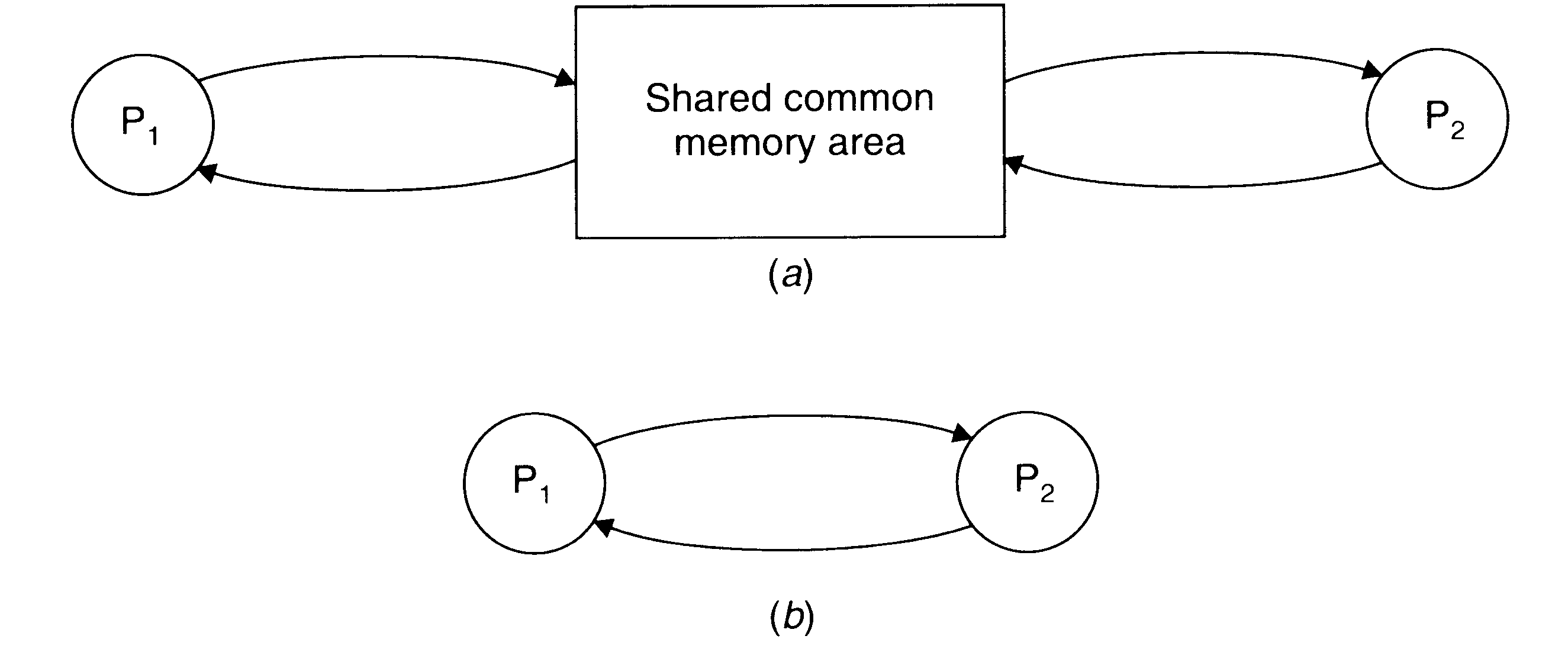
Two basic interprocess communication paradigms: the shared data approach and message passing approach.
In the shared-data approach, the information to be shared is placed in a common memory area that is accessible to all processes involved in an IPC.
In the message-passing approach, the information to be shared is physically copied from the sender process's space to the address space of all the receiver processes, and this is done by transmitting the data to be copied in the form of messages (message is a block of information).
A message-passing system is a subsystem of distributed operating system that provides a set of message-based IPC protocols, and does so by shielding the details of complex network protocols and multiple heterogeneous platforms from programmers. It enables processes to communicate by exchanging messages and allows programs to be written by using simple communication primitives, such as send and receive.
Desirable Features of a Good Message-Passing System
Simplicity
A message passing system should be simple and easy to use. It should be possible to communicate with old and new applications, with different modules without the need to worry about the system and network aspects.
Uniform Semantics
In a distributed system, a message-passing system may be used for the following two types of interprocess communication:
local communication, in which the communicating processes are on the same node;
remote communication, in which the communicating processes are on different nodes.
Semantics of remote communication should be as close as possible to those of local communications. This is an important requirement for ensuring that the message passing is easy to use.
Efficiency
An IPC protocol of a message-passing system can be made efficient by reducing the number of message exchanges, as far as practicable, during the communication process. Some optimizations normally adopted for efficiency include the following:
avoiding the costs of establishing and terminating connections between the same pair of processes for each and every message exchange between them;
minimizing the costs of maintaining the connections;
piggybacking of acknowledgement of previous messages with the next message during a connection between a sender and a receiver that involves several message exchanges.
Correctness
Correctness is a feature related to IPC protocols for group communication. Issues related to correctness are as follows:
atomicity;
ordered delivery;
survivability.
Atomicity ensures that every message sent to a group of receivers will be delivered to either all of them or none of them. Ordered delivery ensures that messages arrive to all receivers in an order acceptable to the application. Survivability guarantees that messages will be correctly delivered despite partial failures of processes, machines, or communication links.
Other features:
reliability;
flexibility;
security;
portability.
Issues in IPC by Message Passing
A message is a block of information formatted by a sending process in such a manner that it is meaningful to the receiving process. It consists of a fixed-length header and a variable-size collection of typed data objects. The header usually consists of the following elements:
Address. It contains characters that uniquely identify the sending and receiving processes in the network.
Sequence number. This is the message identifier (ID), which is very useful for identifying lost messages and duplicate messages in case of system failures.
Structural information. This element also has two parts. The type part specifies whether the data to be passed on to the receiver is included within the message or the message only contains a pointer to the data, which is stored somewhere outside the contiguous portion of the message. The second part of this element specifies the length of the variable-size message data.
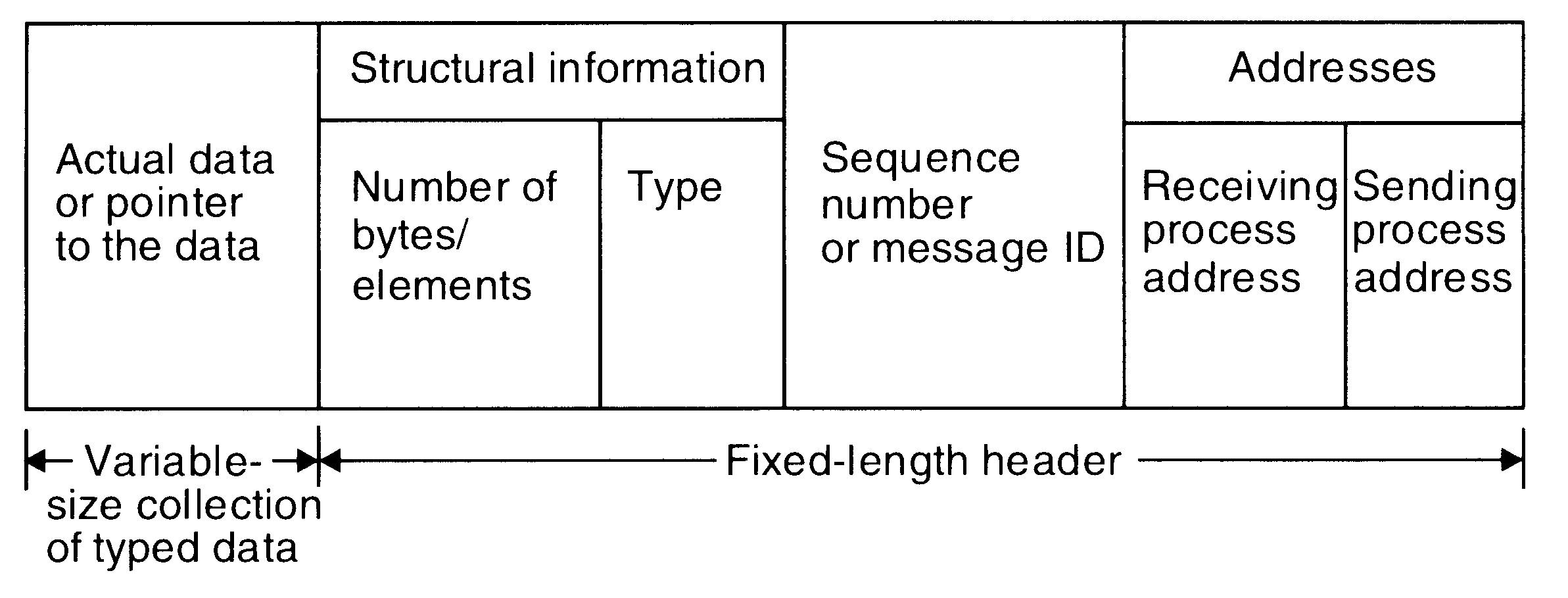
A typical message structure
Synchronization
A central issue in the communication structure is the synchronization imposed on the communicating processes by the communication primitives. The semantics used for synchronization may by broadly classified as blocking and nonblocking types. A primitive is said to have nonblocking semantics if its invocation does not block the execution of its invoker (the control returns almost immediately to the invoker); otherwise a primitive is said to be of the blocking type.
In case of a blocking send primitive, after execution of the send statement, the sending process is blocked until it receives an acknowledgement from the receiver that the message has been received. On the other hand, for nonblocking send primitive, after execution of the send statement, the sending process is allowed to proceed with its execution as soon as the message has been copied to a buffer.
In the case of blocking receive primitive, after execution of the receive statement, the receiving process is blocked until it receives a message. On the other hand, for a nonblocking receive primitive, the receiving process proceeds with its execution after execution of the receive statement, which returns control almost immediately just after telling the kernel where the message buffer is.
An important issue in a nonblocking receive primitive is how the receiving process knows that the message has arrived in the message buffer. One of the following two methods is commonly used for this purpose:
Polling. In this method, a test primitive is provided to allow the receiver to check the buffer status. The receiver uses this primitive to periodically poll the kernel to check if the message is already available in the buffer.
Interrupt. In this method, when the message has been filled in the buffer and is ready for use by the receiver, a software interrupt is used to notify the receiving process.
A variant of the nonblocking receive primitive is the conditional receive primitive, which also returns control to the invoking process almost immediately, either with a message or with an indicator that no message is available.
When both the send and receive primitives of a communication between two processes use blocking semantics, the communication is said to be synchronous, otherwise it is asynchronous. The main drawback of synchronous communication is that it limits concurrency and is subject to communication deadlocks.
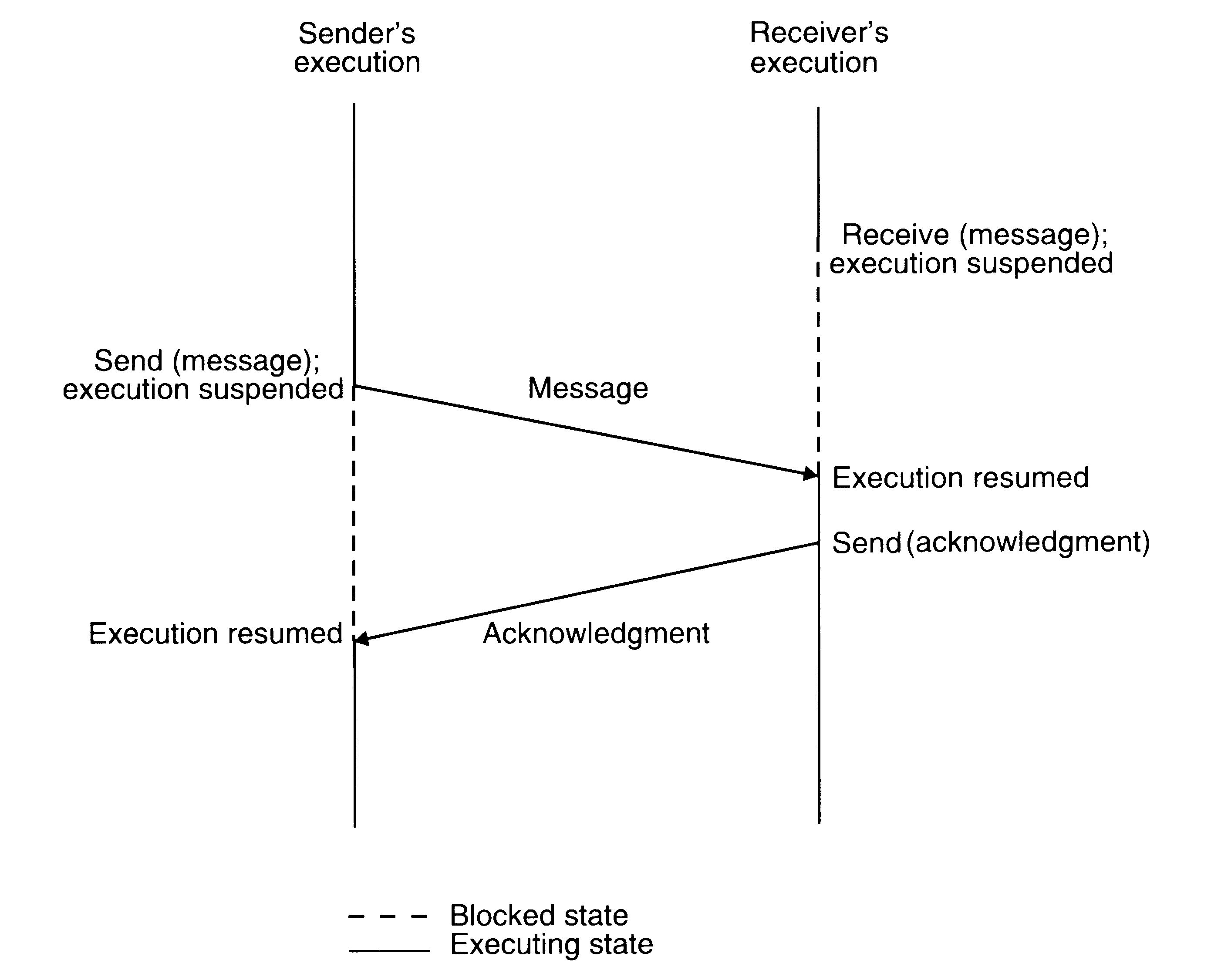
Synchronous mode of communication with both send and receive primitives having blocking-type semantics
Buffering
In the standard message passing model, messages can be copied many times: from the user buffer to the kernel buffer (the output buffer of a channel), from the kernel buffer of the sending computer (process) to the kernel buffer in the receiving computer (the input buffer of a channel), and finally from the kernel buffer of the receiving computer (process) to a user buffer.
Null Buffer (No Buffering)
In this case, there is no place to temporarily store the message. Hence one of the following implementation strategies may be used:
The message remains in the sender process's address space and the execution of the send is delayed until the receiver executes the corresponding receive.
The message is simply discarded and the time-out mechanism is used to resend the message after a timeout period. The sender may have to try several times before succeeding.
The three types of buffering strategies used in interprocess communication
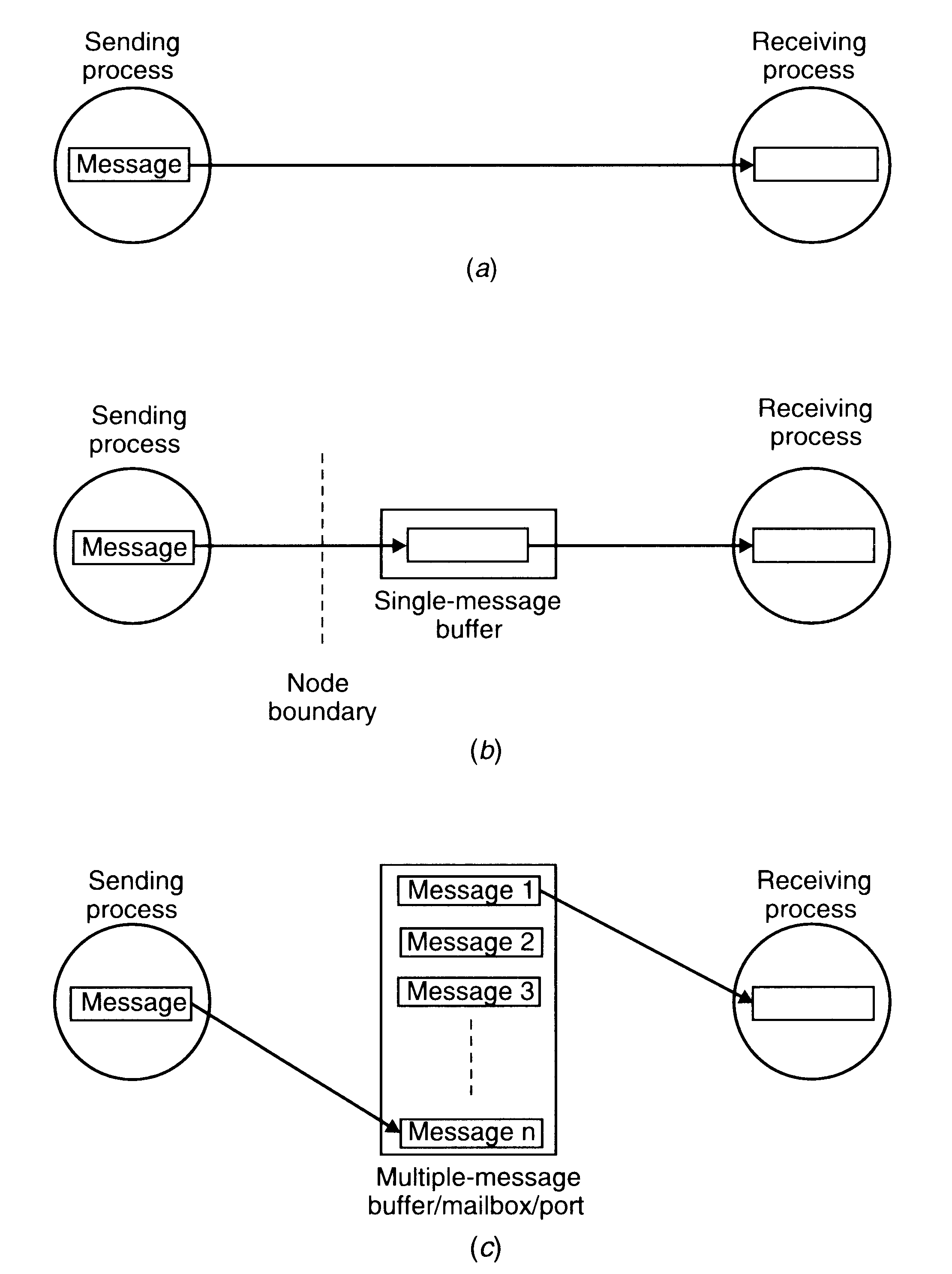
Single-Message Buffer
In single-message buffer strategy, a buffer having a capacity to store a single message is used on the receiver's node. This strategy is usually used for synchronous communication, an application module may have at most one message outstanding at a time.
Unbounded-Capacity Buffer
In the asynchronous mode of communication, since a sender does not wait for the receiver to be ready, there may be several pending messages that have not yet been accepted by the receiver. Therefore, an unbounded-capacity message-buffer that can store all unreceived messages is needed to support asynchronous communication with the assurance that all the messages sent to the receiver will be delivered.
Finite-Bound Buffer
Unbounded capacity of a buffer is practically impossible. Therefore, in practice, systems using asynchronous mode of communication use finite-bound buffers, also known as multiple-message buffers. In this case message is first copied from the sending process's memory into the receiving process's mailbox and then copied from the mailbox to the receiver's memory when the receiver calls for the message.
When the buffer has finite bounds, a strategy is also needed for handling the problem of a possible buffer overflow. The buffer overflow problem can be dealt with in one of the following two ways:
Unsuccessful communication. In this method, message transfers simply fail, whenever there is no more buffer space and an error is returned.
Flow-controlled communication. The second method is to use flow control, which means that the sender is blocked until the receiver accepts some messages, thus creating space in the buffer for new messages. This method introduces a synchronization between the sender and the receiver and may result in unexpected deadlocks. Moreover, due to the synchronization imposed, the asynchronous send does not operate in the truly asynchronous mode for all send commands.
Multidatagram Messages
Almost all networks have an upper bound of data that can be transmitted at a time. This size is known as maximum transfer unit (MTU). A message whose size is greater than MTU has to be fragmented into multiples of the MTU, and then each fragment has to be sent separately. Each packet is known as a datagram. Messages larger than the MTU are sent in miltipackets, and are known as multidatagram messages.
Encoding and Decoding of Messages
A message data should be meaningful to the receiving process. This implies that, ideally, the structure of program objects should be preserved while they are being transmitted from the address space of the sending process to the address space of the receiving process. However, even in homogenous systems, it is very difficult to achieve this goal mainly because of two reasons:
An absolute pointer value loses its meaning when transferred from one process address space to another.
Different program objects occupy varying amount of storage space. To be meaningful, a message must normally contain several types of program objects, such as long integers, short integers, variable-length character strings, and so on.
In transferring program objects in their original form, they are first converted to a stream form that is suitable for transmission and placed into a message buffer. The process of reconstruction of program object from message data on the receiver side is known as decoding of message data. One of the following two representations may by used for the encoding and decoding of a message data:
In tagged representation the type of each program object along with its value is encoded in the message.
In untagged representation the message data only contains program object. No information is included in the message data to specify the type of each program object.
Process Addressing
Another important issue in message-based communication is addressing (or naming) of the parties involved in an interaction. For greater flexibility a message-passing system usually supports two types of process addressing:
Explicit addressing. The process with which communication is desired is explicitly named as a parameter in the communication primitive used.
Implicit addressing. The process willing to communicate does not explicitly name a process for communication (the sender names a server instead of a process). This type of process addressing is also known as functional addressing.
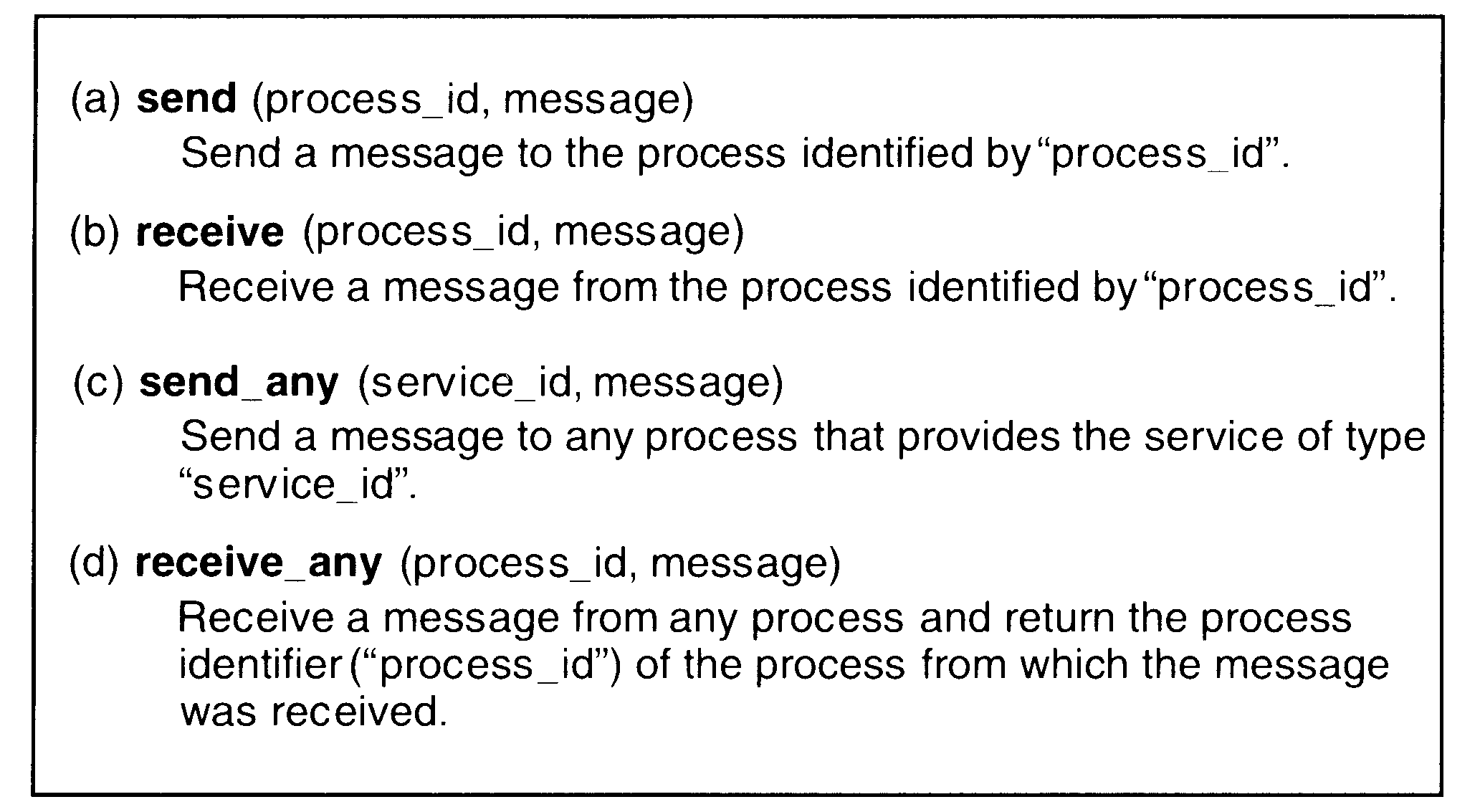
Methods to Identify a Process (naming)
A simple method to identify a process is by a combination of machine_id and local_id. The local_id part is a process identifier, or a port identifier of a receiving process, or something else that can by used to uniquely identify a process on a machine. The machine_id part of the address is used by the sending machine's kernel to send the message to the receiving process's machine, and the local_id part of the address is then used by the kernel of the receiving process's machine to forward the message to the process for which it is intended.
A drawback of this method is that it does not allow a process to migrate from one machine to another if such a need arises.
To overcome the limitation of the above method, process can be identified by a combination of the following three fields: machine_id, local_id and machine_id.
The first field identifies the node on which the process was created.
The second field is the local identifier generated by the node on which the process was created.
The third field identifies the last known location (node) of the process.
Another method to achieve the goal of location transparency in process addressing is to use a two-level naming scheme for processes. In this method each process has two identifiers: a high-level name that is machine independent (an ASCII string) and the low-level name that is machine dependent (such as pair (machine_id, local_id). A name server is used to maintain a mapping table that maps high-level names of processes to their low-level names.
Failure Handling
During interprocess communication partial failures such as a node crash or communication link failure may lead to the following problems:
Loss of request message. This may happen either due to the failure of communication link between the sender and receiver or because the receiver's node is down at the time the request message reaches there.
Loss of response message. This may happen either due to the failure of communication link between the sender and receiver or because the sender's node is down at the time the response message reaches there.
Unsuccessful execution of the request. This may happen due to the receiver's node crashing while the request is being processed.
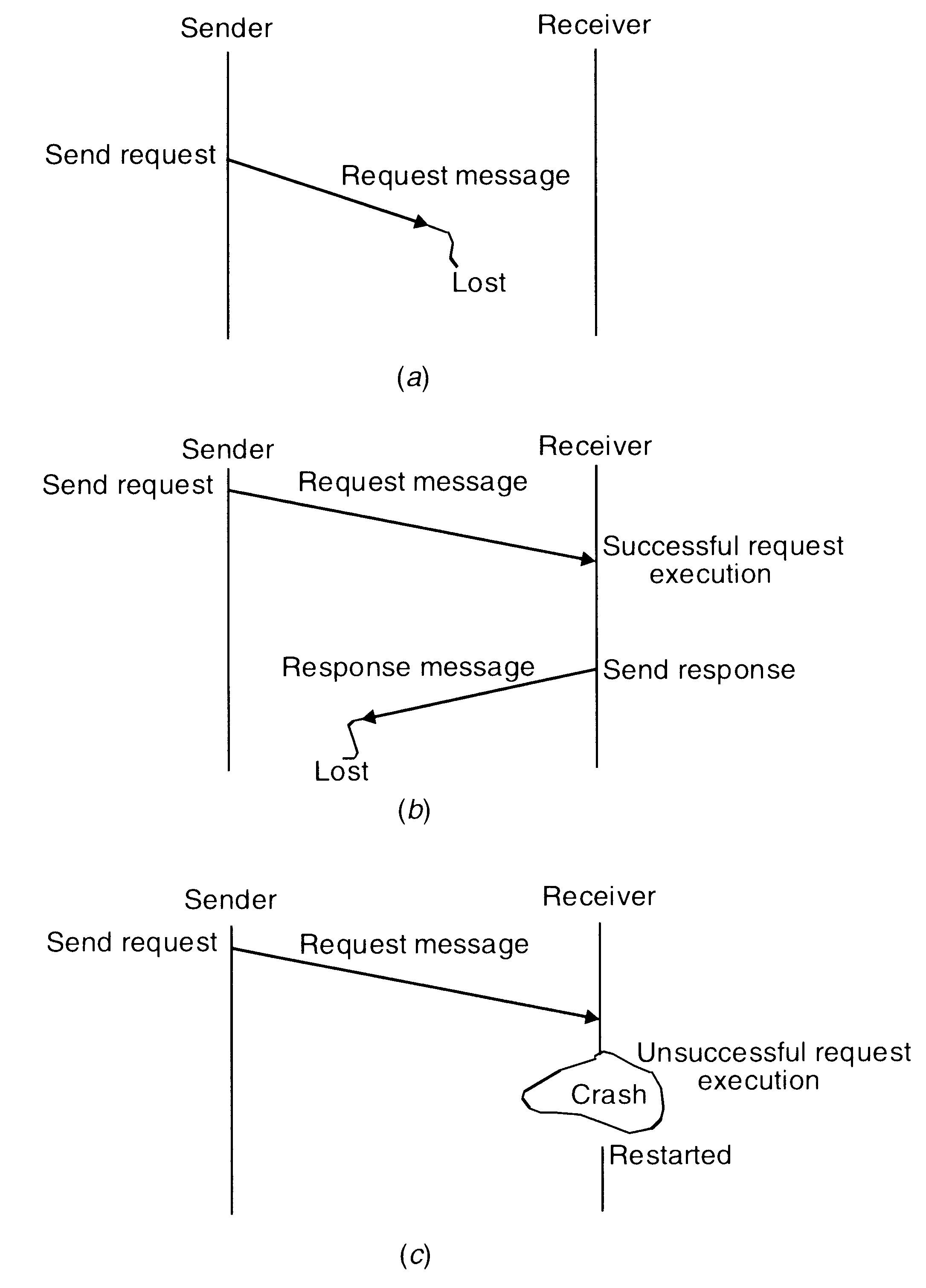
Possible problems in IPC due to different types of system failures
Four-message reliable IPC protocol for client-server communication between two processes works as follows:
The client sends a request message to the server.
When the request message is received at the server's machine, the kernel of that machine returns an acknowledgment message to the kernel of the client machine. If the acknowledgment is not received within the timeout period, the kernel of the client machine retransmits the request message.
When the server finishes processing the client's request it returns a reply message (containing the result of processing) to the client.
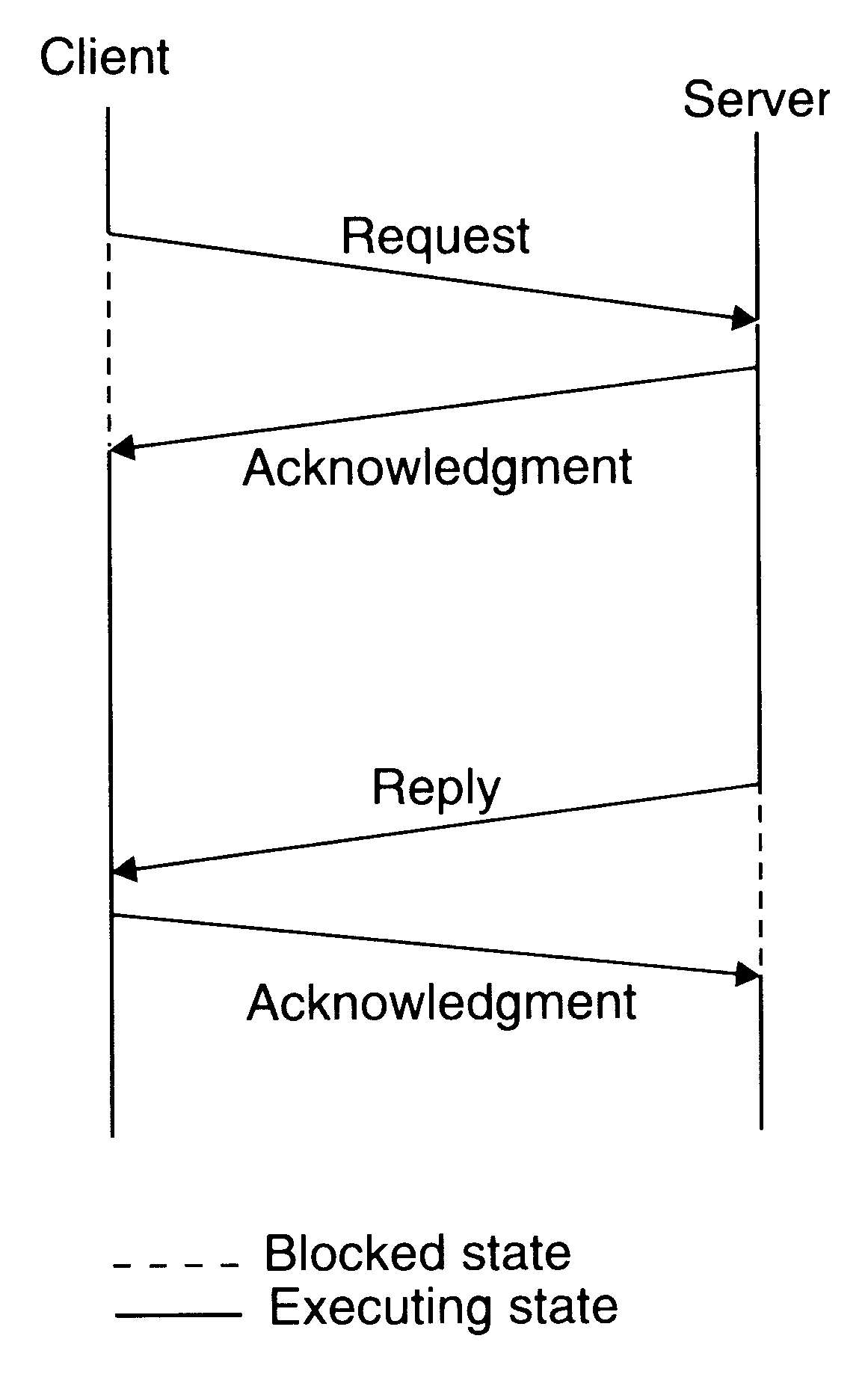
When the reply is received at client machine, the kernel of that machine returns an acknowledgment message to the kernel of the server machine. If the acknowledgment message is not received within the timeout period, the kernel of the server machine retransmits the reply message.
The four message reliable IPC
In client-server communication, the result of the processed request is sufficient acknowledgment that the request message was received by the server. Based on this idea, a three-message reliable IPC protocol for client-server communication between two processes works as follows:
The client sends a request message to the server.
When the server finishes processing the client's request, it returns a reply message (containing the result of processing) to the client. The client remains blocked until the reply is received. If the reply is not received within the timeout period, the kernel of the client machine retransmits the request message.
When the reply message is received at the client's machine, the kernel of that machine returns an acknowledgment message to the kernel of the sever machine. If the acknowledgment message is not received within the timeout period, the kernel of the server machine retransmits the reply message.
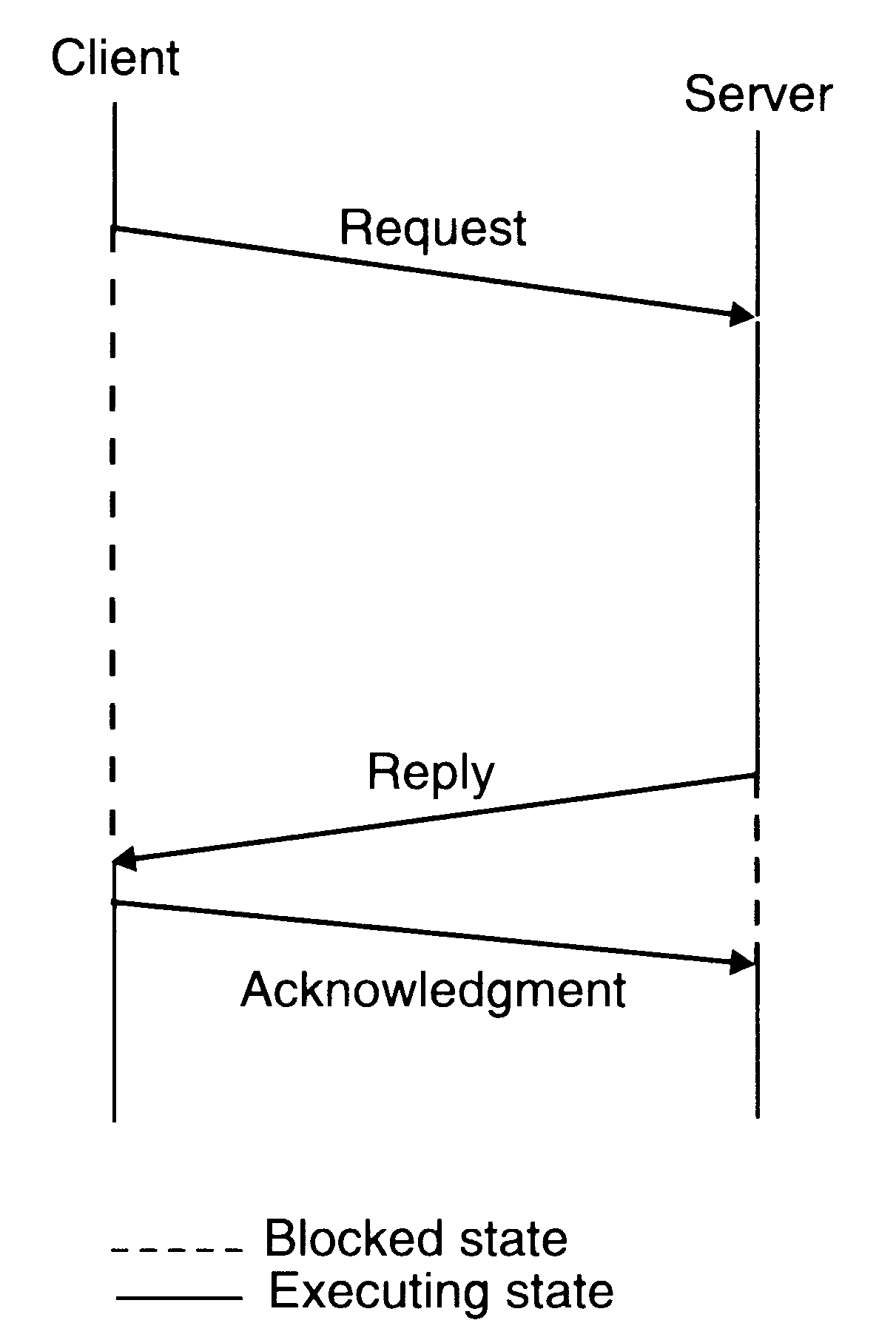
The three message reliable IPC
A problem occurs if a request processing takes a long time. If the request message is lost, it will be retransmitted only after the timeout period, which has been set to a large value to avoid unnecessary retransmission of the request message. On the other hand, if the timeout value is not set properly taking into consideration the long time needed for request processing, unnecessary retransmissions of the request message will take place.
The following protocol may be used to handle this problem:
The client sends a request message to the server.
When the request message is received at the server's machine, the kernel of that machine starts a timer. If the server finishes processing the client's requests and returns the reply message to the client before the timer expires, the reply serves as the acknowledgment of the request message. Otherwise, a separate acknowledgment is sent by the kernel of the server machine to acknowledge the request message. If an acknowledgement is not received within the timeout period, the kernel of the client machine retransmits the request message.
When the reply message is received, at the client's machine, the kernel of that machine returns an acknowledgment message to the kernel of the server machine. If the acknowledgment message is not received within the timeout period, the kernel of the server retransmits the reply message.
A message-passing system may be designed to use the following two-message IPC protocol for client-server communication between two processes:
The client sends a request message to the server and remains blocked until a reply is received from the server.
When the server finishes processing the client's request, it returns a reply message (containing the result of processing) to the client. If the reply is not received within the timeout period, the kernel of the client machine retransmits the request message.
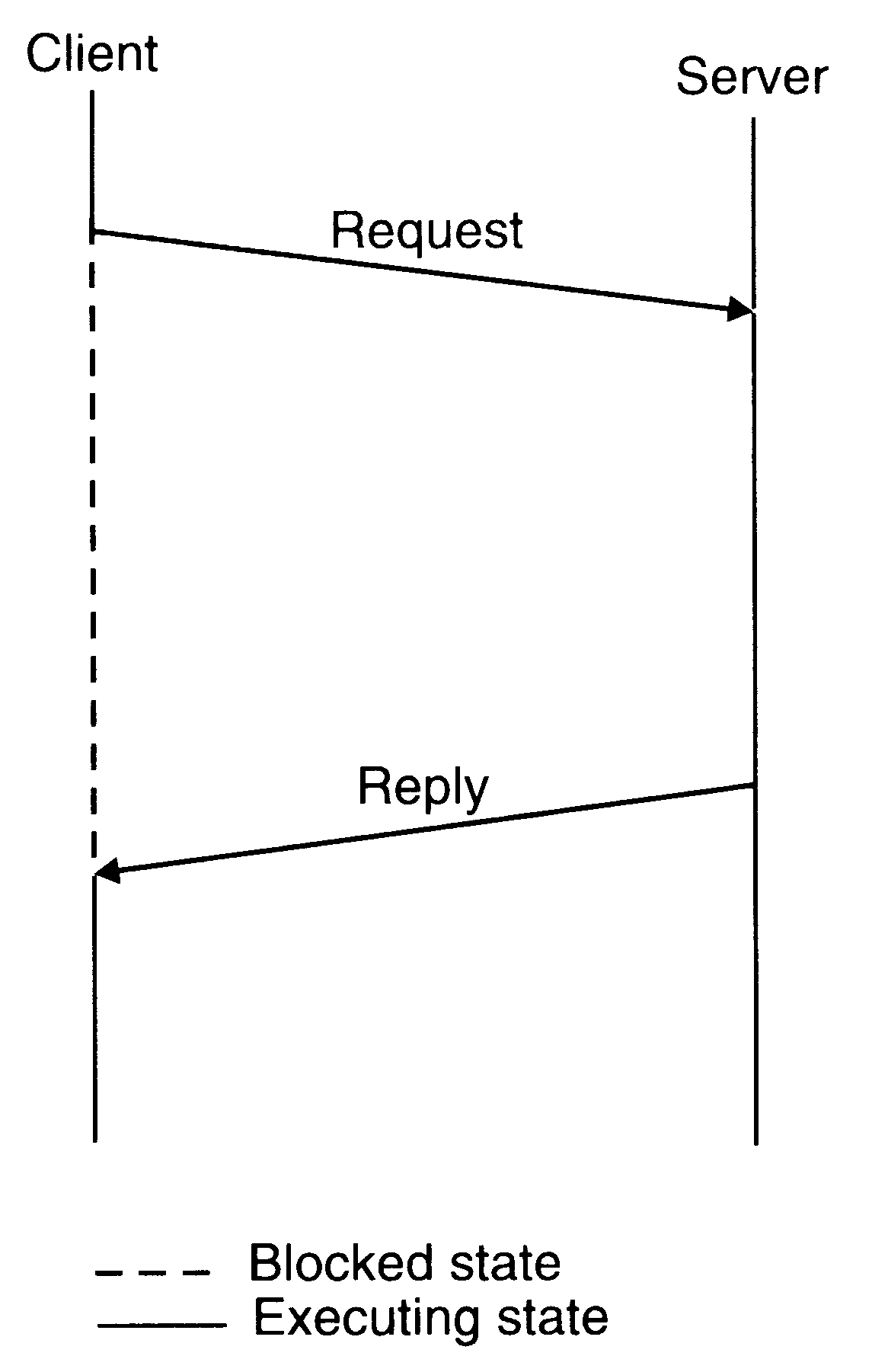
Two message IPC protocol used in many systems for client-server communication
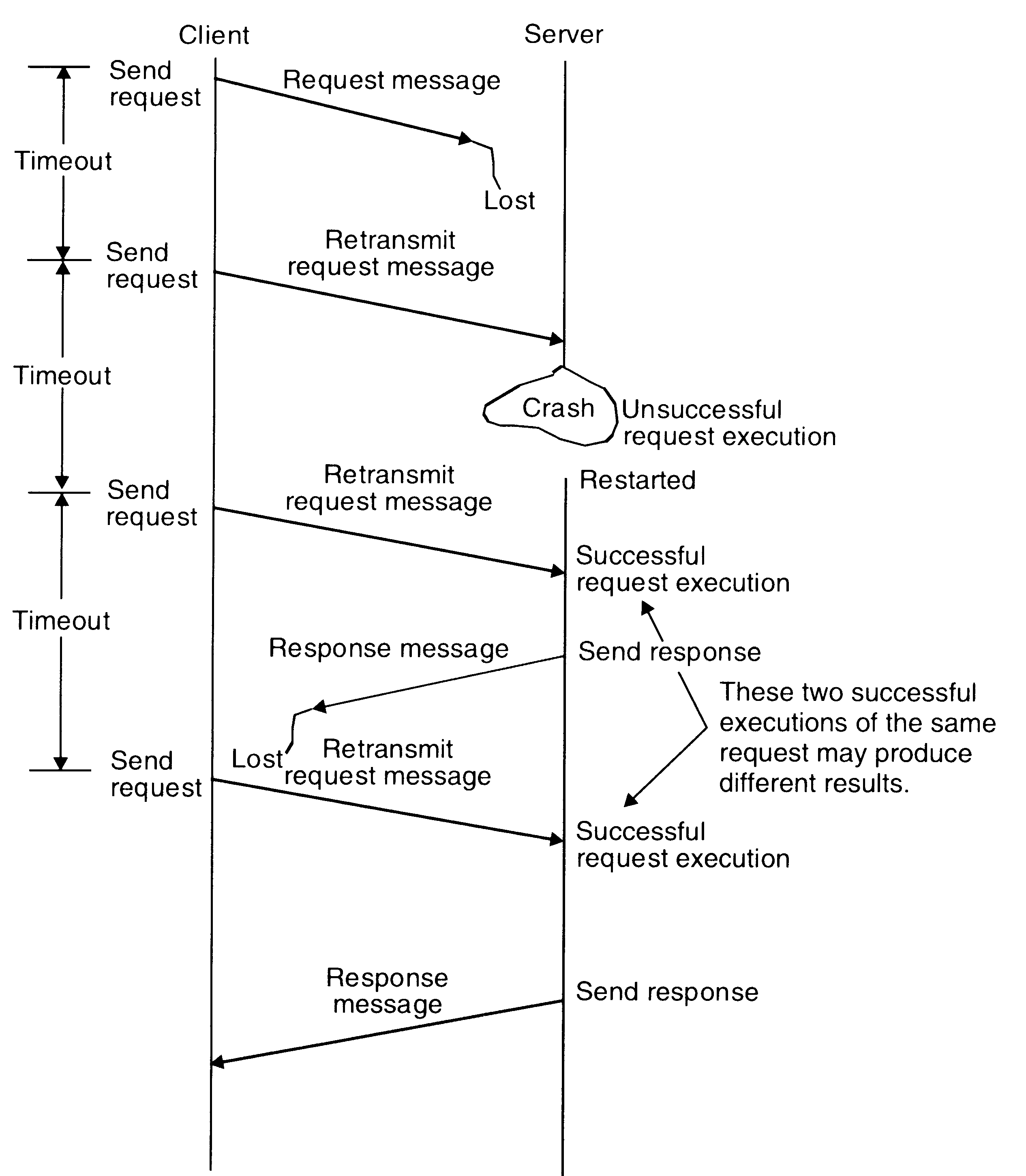
An example of fault tolerant communication between a client and a server.
Idempotency
Idempotency basically means „repeatability”. That is, an idempotent operation produces the same results without any side effects no matter how many times it is performed with the same arguments.
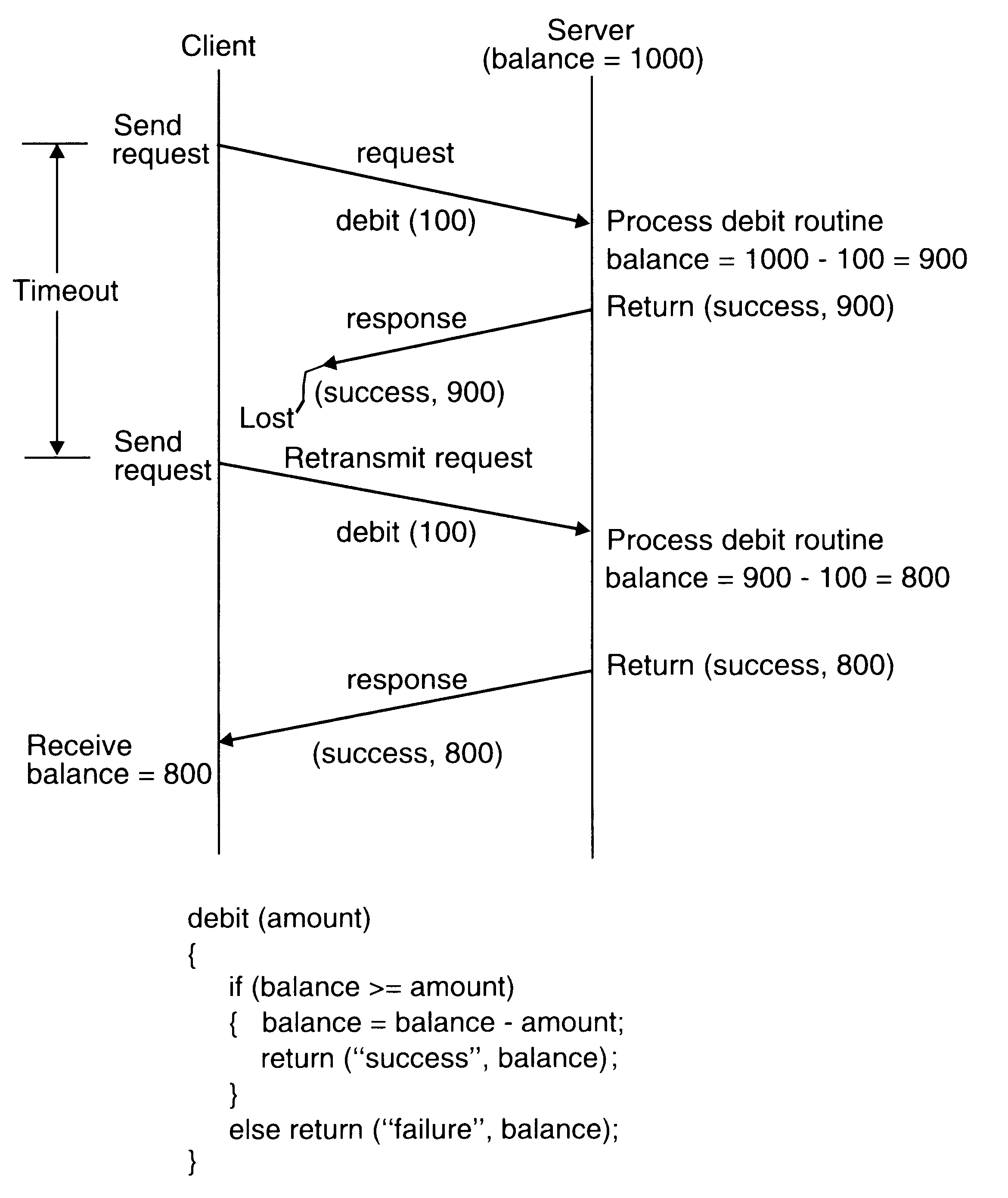
A nonidempotent routine
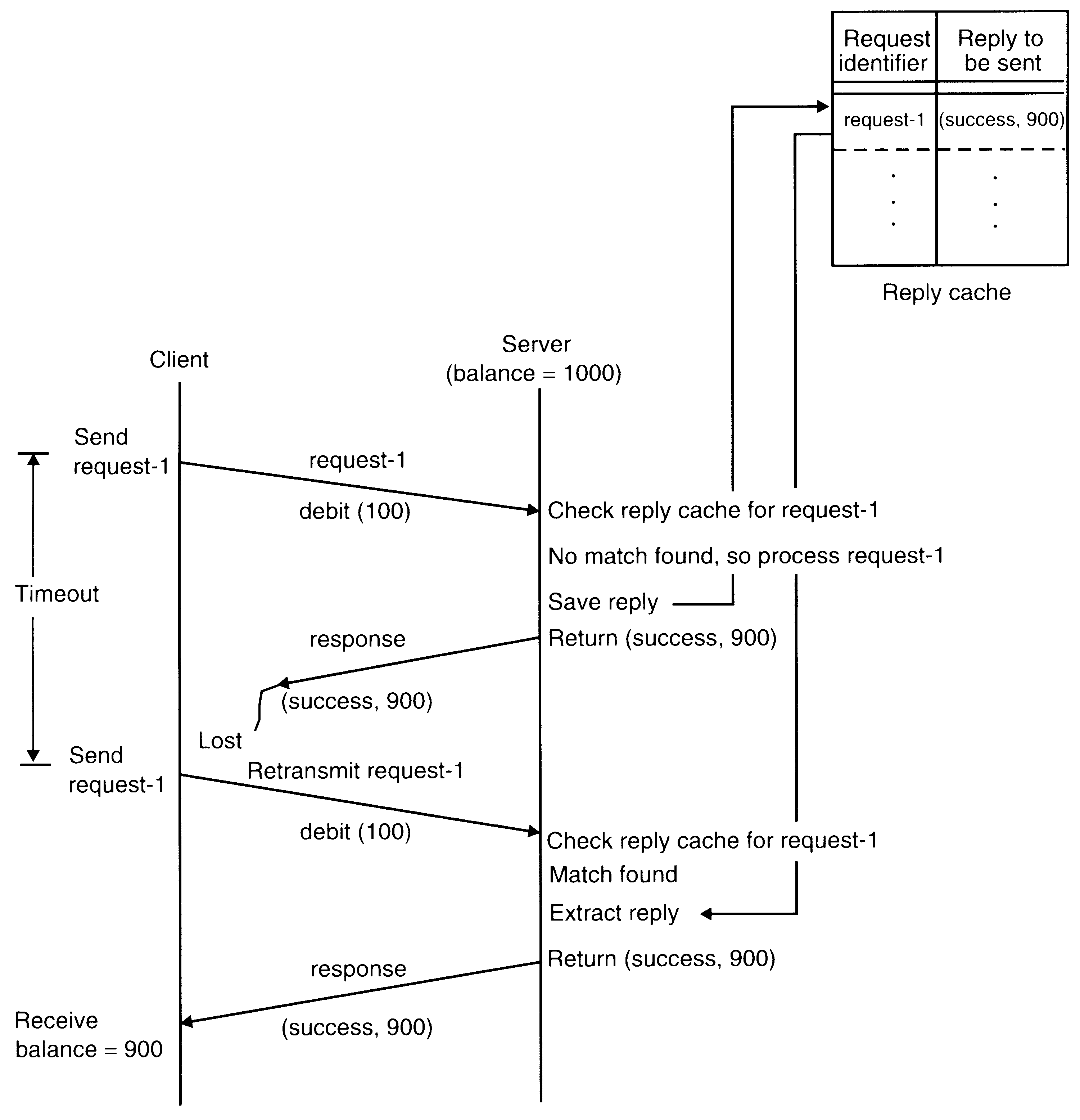
An example of exactly-once semantics using request identifiers and reply cache
Keeping track of Lost and Out-of-Sequence Packet in Multidatagram Messages
A message transmission can be considered to be complete only when all the packets of the message have been received by the process to which it is sent. For successful completion of a multidatagram message transfer, reliable delivery of every packet is important. A simple way to ensure this is to acknowledge each packet separately (called stop-and-wait protocol). To improve communication performance, a better approach is to use a single acknowledgment packet for all the packets of a multidatagram message (called blast protocol). However, when this approach is used, a node crash or a communication link failure may lead to the following problems:
One or more packets of the multidatagram message are lost in communication.
The packets are received out of sequence by the receiver.
An efficient mechanism to cope with these problems is to use a bitmap to identify the packets of a message.
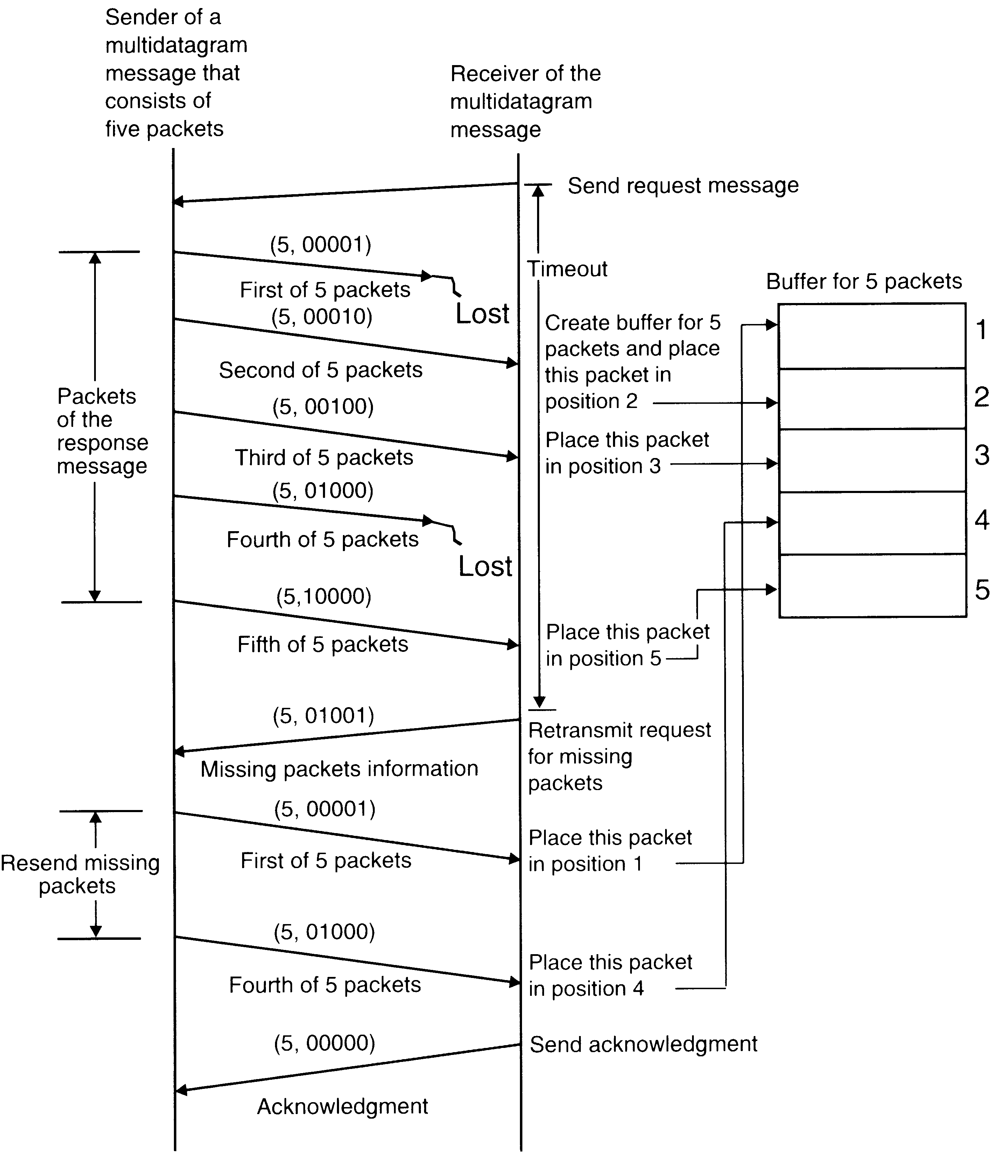
An example of the use of a bitmap to keep track of lost and out of sequence packets in a multidatagram message transmission
Group Communication
The most elementary form of message-based interaction is one-to-one communication (also known as point-to-point, or unicast communication) in which a single-sender process sends a message to a single-receiver process. For performance and ease of programming, several highly parallel distributed applications require that a message-passing system should also provide group communication facility. Depending on single or multiple senders and receivers, the following three types of group communication are possible:
One to many (single sender and multiple receivers).
Many to one (multiple senders and single receivers).
Many to many (multiple senders and multiple receivers).
One-to-Many Communication
In this scheme, there are multiple receivers for a message sent by a single sender. One-to-many scheme is also known as multicast communication. A special case of multicast communication is broadcast communication, in which the message is sent to all processors connected to a network.
Group Management
In case of one-to-many communication, receiver processes of a message form a group. Such groups are of two types - closed and open. A closed group is one in which only the members of the group can send a message to the group. An outside process cannot send a message to the group as a whole, although it may send a message to an individual member of the group. On the other hand, an open group is one in which any process in the system can send a message to the group as a whole.
Group Addressing
A two-level naming scheme is normally used for group addressing. The high-level grup name is an ASCII string that is independent of the location of the processes in the group. On the other hand, the low-level group name depends to a large extent on the underlying hardware.
On some networks it is possible to create a special network address to which multiple machines can listen. Such a network address is called a multicast address. Therefore, in such systems a multicast is used as a low-level name for a group.
Some networks that do not have the facility to create multicast address may have broadcast facility. A packet sent to a broadcast address is automatically delivered to all machines in the network. In this case, the software of each machine must check to see if the packet is intended for it.
If a network does not support either the facility to create multicast address or the broadcasting facility, a one-to-one communication mechanism has to be used to implement the group communication facility. That is, the kernel of the sending machine sends the message packet separately to each machine that has a process belonging to the group. Therefore, in this case, the low-level name of a group contains a list of machine identifiers of all machines that have a process belonging to the group.
Buffered and Unbuffered Multicast
Multicasting is an asynchronous communication mechanism. This is because multicast send cannot be synchronous due to the following reasons:
It is unrealistic to expect a sending process to wait until all the receiving processes that belong to the multicast group are ready to receive the multicast message.
The sending process may not be aware of all the receiving processes that belong to the multicast group.
For an unbuffered multicast, the message is not buffered for the receiving process and is lost if the receiving process is not in a state ready to receive it. Therefore, the message is received only by those processes of the multicast group that are ready to receive it. On the other hand, for a buffered multicast, the message is buffered for the receiving process, so each process of the multicast group will eventually receive the message.
Send-to-All and Bulletin-Board Semantics
Ahamad and Berstain [1985] described the following two types of semantics for one-to-many communications:
Send-to-all semantics. A copy of the message is sent to each process of the multicast group and message is buffered until it is accepted by the process.
Bulletin-board semantics. A message to be multicast is addressed to a channel instead of being sent to every individual process of the multicast group. From a logical point of view, the channel plays the role of a bulletin board. A receive process copies the message from the channel instead of removing it when it makes a receive request on the channel.
Bulletin-board semantics is more flexible than send-to-all semantics because it takes care of the following two factors that are ignored by send-to-all semantics:
The relevance of message to a particular receiver may depend on the receiver's state.
Messages not accepted within a certain time after transmission may no longer be useful; their value may depend on the sender's state.
Flexible Reliability in Multicast Communication
Different applications require different degrees of reliability. The sender of a multicast message can specify the number of receivers from which a response message is expected. In one-to-many communication, the degree of reliability is normally expressed in the following forms:
The 0-reliability. No response is expected by the sender from any of the receivers.
The 1-reliability. The sender expects a response from any of the receivers.
The m-out-of-n-reliable. The multicast group consists of n receivers and the sender expects a response from m (1<m<n) of the receivers.
All-reliable. The sender expects a response message from all the receivers of the multicast group.
Atomic Multicast
Atomic multicast (reliable multicast) has an all-or-nothing property. That is, when a message is sent to a group by atomic multicast, it is either received by all the surviving (correct) processes that are members of the group or else it is not received by any of them.
When a sender is reliable and network partition is excluded, a simple way to implement atomic multicast is to multicast a message, with the degree of reliability requirement being all-reliable. In this case, the kernel of the sending machine sends the message to all members of the group and waits for an acknowledgment from each member.
The above approach is not sufficient when considering possible failures of the sender's machine or a receiver's machine.
One method to implement atomic (reliable) multicast is the following.
Each message has a message identifier field to distinguish it from all other messages and a field to indicate that it is an atomic multicast message. The sender sends the message to a multicast group. The kernel of the sending machine sends the message to all members of the group and uses timeout-based retransmissions as in the previous method. A process that receives the message checks its message identifier field to see if it is a new message. If not, it is simply discarded. Otherwise, the receiver checks to see if it is an atomic multicast message. If so, the receiver also performs an atomic multicast of the same message, sending it to the same multicast group. The kernel of this machine treats this message as an ordinary atomic multicast message and uses timeout-based retransmission when needed. In this way, each receiver of an atomic multicast message will perform an atomic multicast of the message to the same multicast group.
The method ensures that eventually all the surviving processes of the multicast group will receive the message even if the sender machine fails after sending the message or a receiver machine fails after receiving the message.
Many-to-One Communication
In this scheme, multiple senders send messages to a single receiver. The single receiver may be selective or nonselective. A selective receiver specifies a unique sender; a message exchange takes place only if that sender sends a message. On the other hand, a nonselective receiver specifies a set of senders, and if any one sender in the set sends a message to this receiver, a message exchange takes place. An important issue related to the many-to-one communication scheme is nondeterminism. It is not known in advance which member (or members) of the group will have its information available first.
Many-to-Many Communication
In this scheme, multiple senders send messages to multiple receivers. An important issue related to many-to-many communication scheme is that of ordered message delivery. Ordered message delivery ensures, that all messages are delivered to all receivers in an order acceptable to the application.
No ordering constraints for message delivery
Absolute Ordering
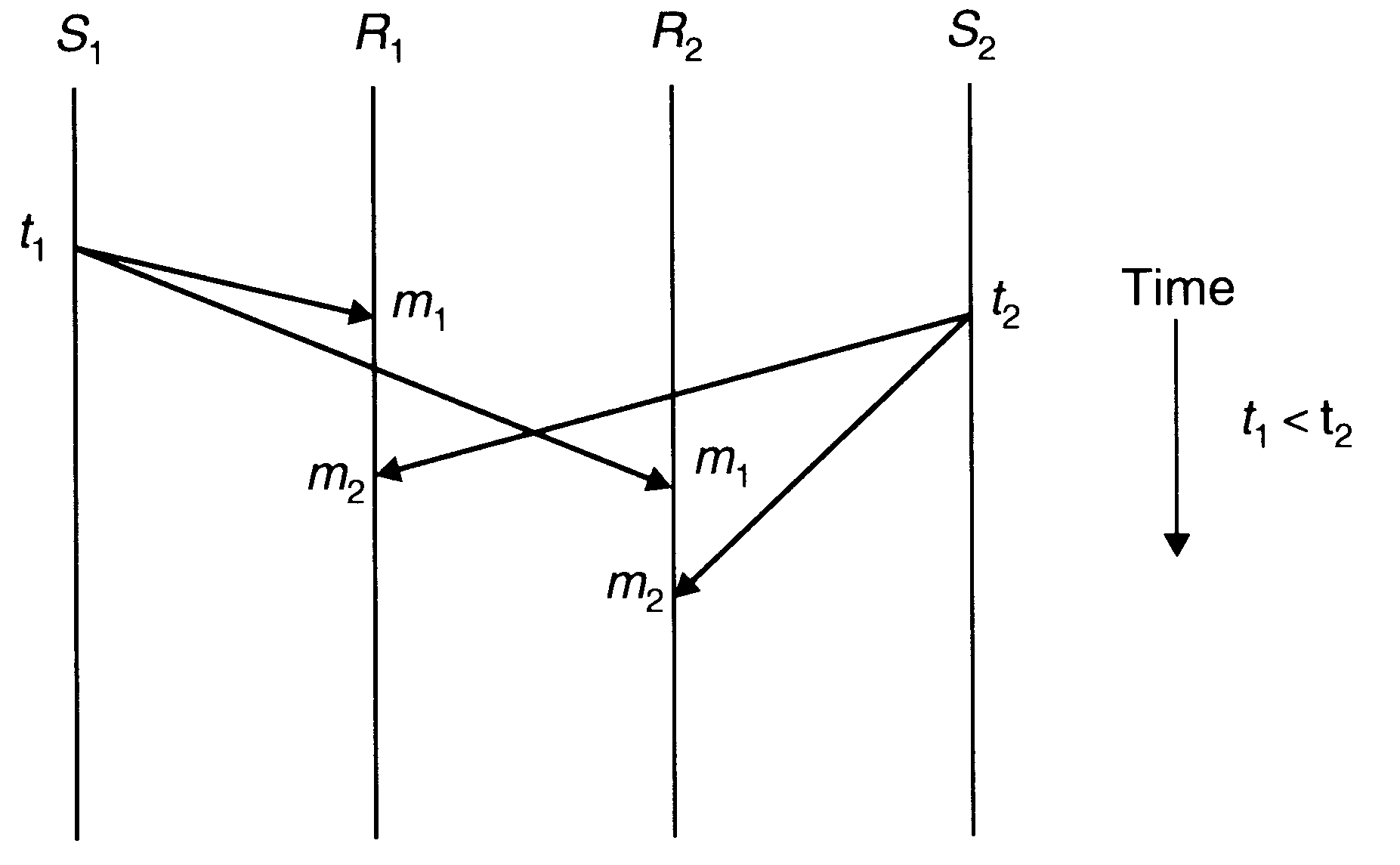
The absolute ordering semantics ensures that all messages are delivered to all receiver processes in the exact order in which they were sent. One method to implement this semantics is to use global timestamps as message identifiers. That is, the system is assumed to have a clock at each machine and all clocks are synchronized with each other, and when a sender sends a message, the clock value (timestamp) is taken as the identifier of that message and the timestamp is embedded in the message.
Absolute ordering of messages
To implement absolute ordering semantics, the kernel of each receiver's machines saves all incoming messages meant for a receiver in a separate queue.
A sliding-window mechanism is used to periodically deliver the message from the queue to the receiver. That is, a fixed time interval is selected as the window size, and periodically all messages whose timestamp values fall within the current window are delivered to the receiver. Messages whose timestamp values fall outside the window are left in the queue because of the possibility that a tardy message having a timestamp value lower than that of any of the messages in the queue might still arrive.
The window size must be properly chosen taking into consideration the maximum possible time that may be required by a message to go from one machine to any other machine in the network.
Consistent Ordering (Total Ordering)
Absolute-ordering semantics requires globally synchronized clocks, which are not easy to implement. Moreover, absolute ordering is not really what many applications need to function correctly. Therefore, instead of supporting absolute ordering semantics, most systems support consistent-ordering semantics (total order semantics). This semantics ensures that all messages are delivered to all receiver processes in the same order. However, this order may be different from the order in which messages were sent.
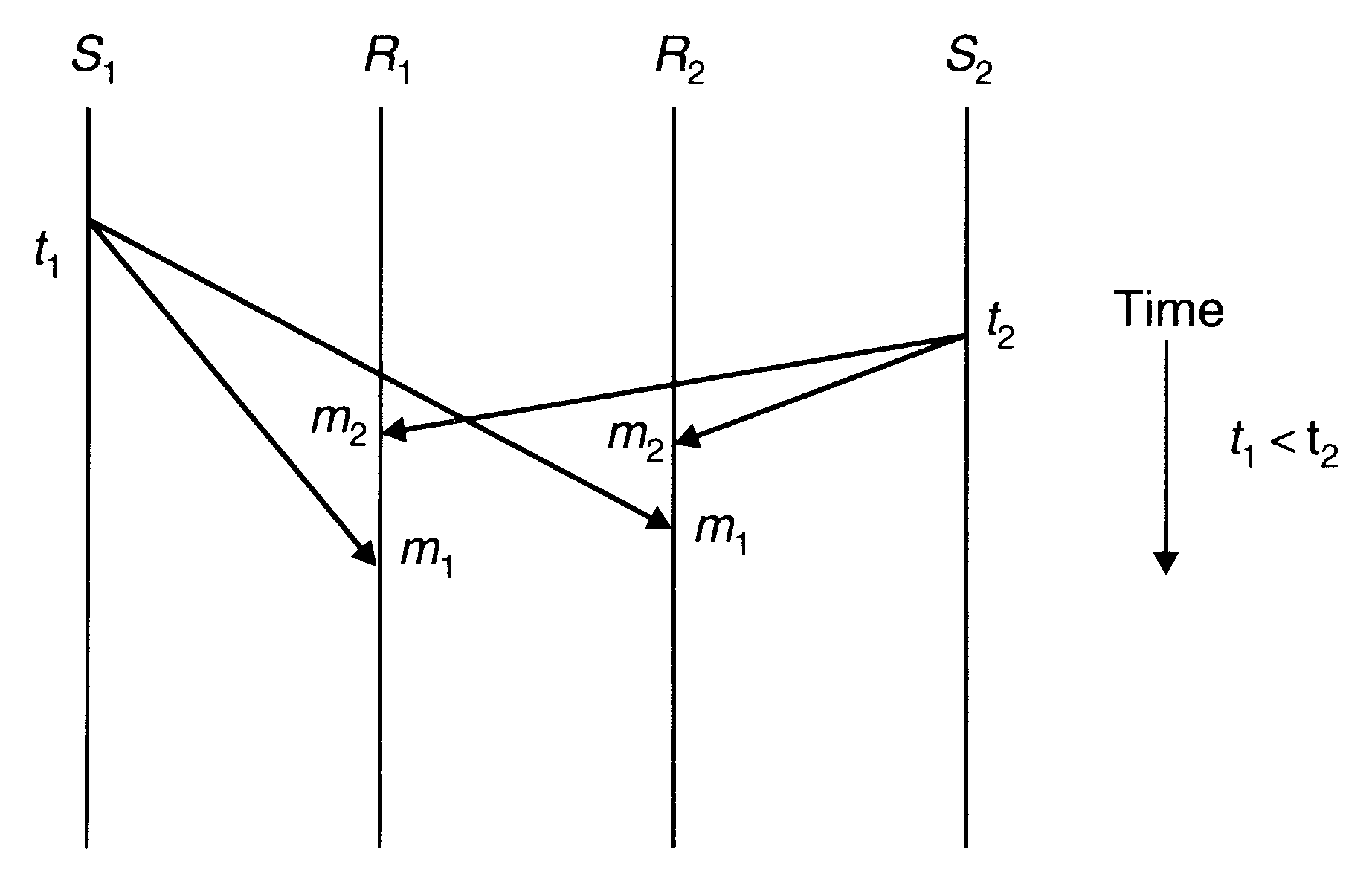
Consistent ordering of messages
One method to implement consistent-ordering semantics is to make the many-to-many scheme appear as a combination of many-to-one and one-to-many schemes. That is, the kernels of the sending machines send messages to a single receiver (known as sequencer) that assigns a sequence number to each message and then multicasts it. The kernel of each receiver's machine saves all incoming messages meant for a receiver in a separate queue.
The sequencer-based method for implementing consistent-ordering semantics is subject to single point of failure and hence has poor reliability. A distributed algorithm for implementing consistent-ordering semantics that does not suffer from this problem is the ABCAST protocol of the ISIS system. It assigns a sequence number to a message by distributed agreement among the group members and the sender, and works as follows:
The sender assigns a temporary sequence number (integer) to the message and sends it to all members of the multicast group. The sequence number assigned by the sender must be larger than any previous sequence number used by the sender. Therefore, a simple counter can be used by the sender to assign sequence numbers to its messages.
On receiving the message, each member of the group returns a proposed sequence number to the sender. A member (i) calculates its proposed sequence number by using the function: Max(Fmax, Pmax)+1+i/N, where integer Fmax is truncated the largest final sequence number agreed upon so far for a message received by the group (each member makes a record of this when a final sequence number is agreed upon), integer Pmax is truncated the largest proposed sequence number by this member, and N is the total number of members in the multicast group.
When the sender has received the proposed sequence number from all the members, it selects the largest one as the final sequence number for the message and sends it to all members in a commit message. The chosen final sequence number is guaranteed to be unique because of the term i/N in the function used for the calculation of a proposed sequence number.
On receiving the commit message, each member attaches the final sequence number to the message.
Committed messages with final sequence numbers are delivered to the application programs in order of their final sequence numbers.
Causal Ordering
For some applications consistent-ordering semantics is not necessary and even weaker semantics is acceptable. Therefore, an application can have better performance if the message-passing system used supports a weaker ordering semantics that is acceptable to the application. One such weaker ordering semantics that is acceptable to many applications is the causal ordering semantics. This semantics ensures that if the event of sending one message is causally related to the event of sending another message, the two messages are delivered to all receivers in the correct order. However, if two message-sending events are not causally related, the two messages may be delivered to the receivers in any order. Two message-sending events are said to be causally related if they are correlated by the happened-before relation.
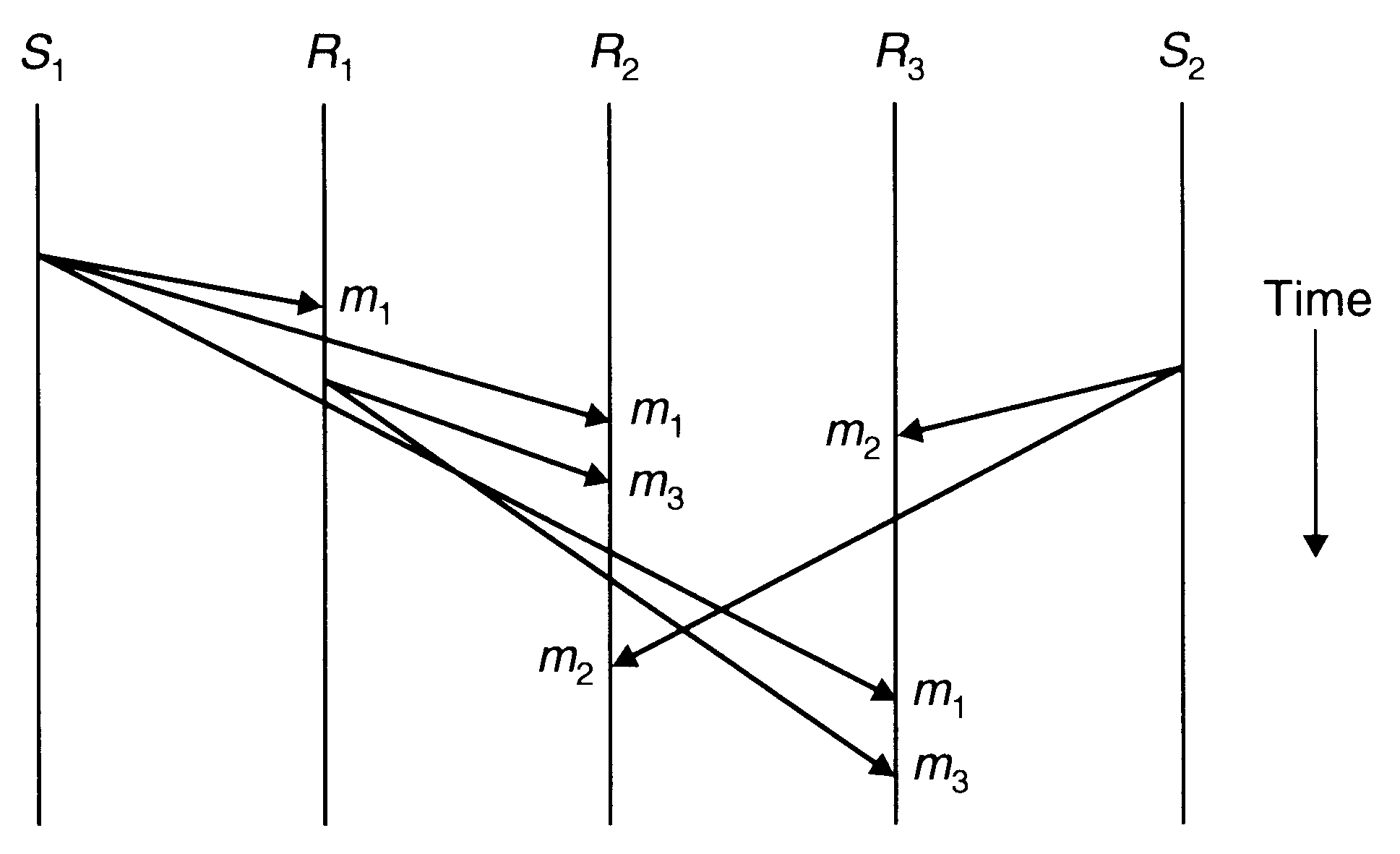
Causal ordering of messages
One method for implementing causal-ordering semantics is the CBCAST protocol of the ISIS system. It assumes broadcasting of all messages to group members and works as follows:
Each member process of a group maintains a vector of n components, where n is the total number of members in the group. Each member is assigned a sequence number from 0 to n-1, and the i-th component of the vectors corresponds to the member with sequence number i. In particular, the value of i-th component of a member's vector is equal to the number of the last message received in sequence by this member from member i.
To send a message, a process increments the value of its own component in its own vector and sends the vector as part of the message.
When the message arrives at a receiver process's site, it is buffered by the runtime system. The runtime system tests the two conditions given below to decide whether the message can be delivered to the user process or its delivery must be delayed to ensure causal-ordering semantics. Let S be the vector of the sender process that is attached to the message and R be the vector of the receiver process. Also let i be the sequence number of the sender process. Then the two conditions to be tested are:
S[i]=R[i]+1
S[j]<=R[j] for all j not equal i
The first condition ensures that the receiver has not missed any message from the sender. This test is needed because two messages from the same sender are always causally related. The second condition ensures that the sender has not received any messages that the receiver has not yet received. This test is needed to make sure that the sender's message is not causally related to a message missed by the receiver.
If the message passes these two tests, the runtime system delivers it to the user process. Otherwise, the message is left in the buffer and the test is carried out again for it when a new message arrives.
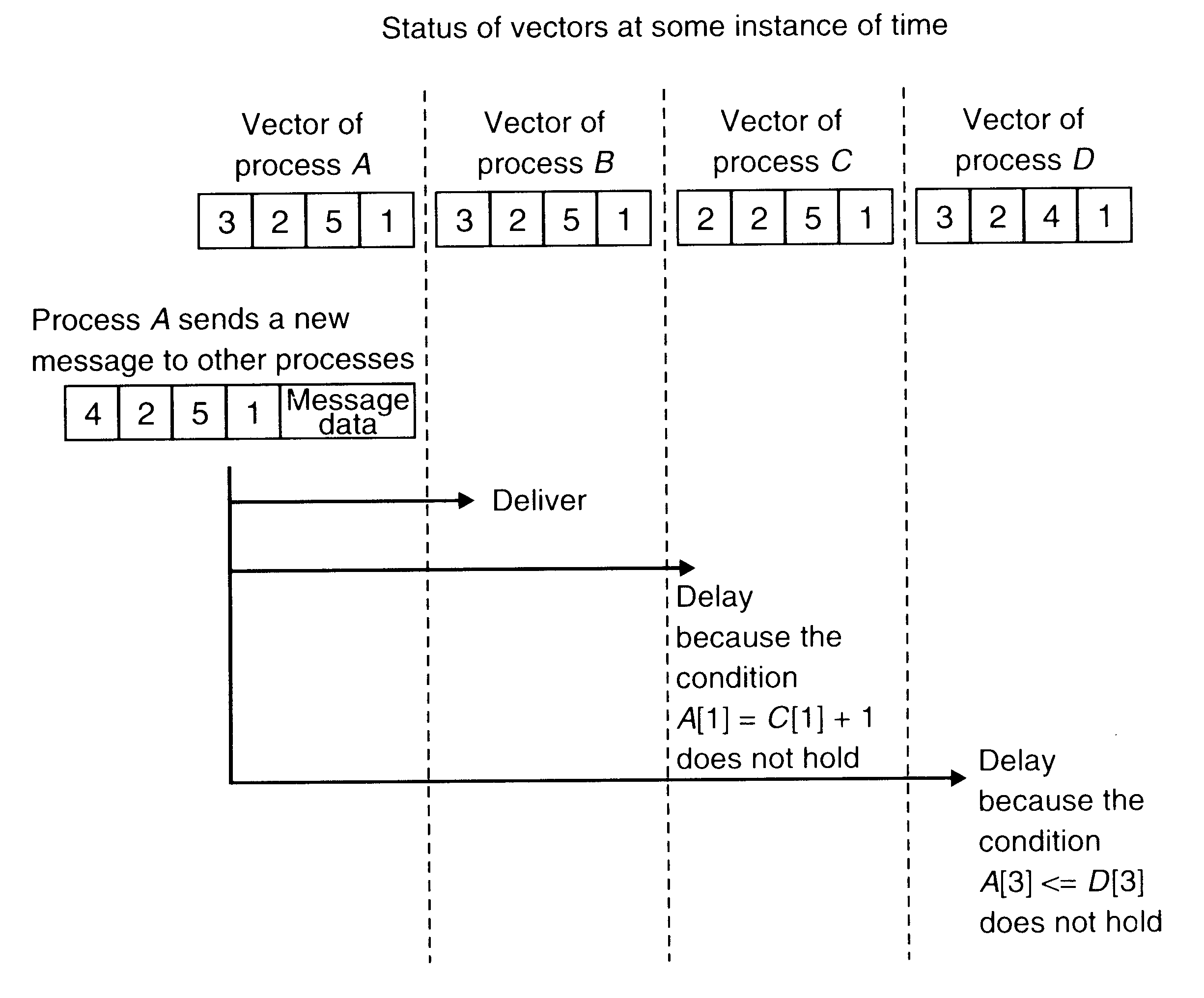
An example to illustrate the CBCAST protocol for implementing causal ordering semantics
Causal ordering of messages - formal description and algorithms
A distributed system guarantees causal ordering of messages iff the following implication holds:
(send(m1)
send(m2)) => (rec(m1)
rec(m2)
Example:
Birman - Schiper - Stephenson Algorithm (Protocol)
Algorithm
1) A process Pj, before broadcasting a message m:
do " increment the vector time VTPj[j] and timestamp m";
/* Note that (VTPj[j]-1) indicates how many messages from Pj precede m */
end do
2) A process Pj Pi, upon receiving message m timestamped VTm from Pi:
do "delay its delivery until both the following conditions are satisfied:
a. VTpj[i] = VTm[i]-1
b. VTpj[k] VTm[k] , k {1, 2, ..., n} - {i}"
/* where n is the total number of processes. Delayed messages are queued at each process in a queue that is sorted by vector time of messages. Concurrent messages are ordered by the time of their receipt */
end do
3) When a message is delivered at a process Pj:
do "update VTpj accordingly to the vector clock updating rule"
end do
Schiper - Eggli - Sandoz Algorithm
Each process P maintains a vector denoted by V_P of size n-1, where n is the number of processes in the system. An element V_P is an ordered pair (P', t), where P' is the ID of the destination process of a message and t is a vector timestamp. The processes in the system are assumed to use vector clocks. The communication channels can be non-FIFO. The following notations are used in describing the algorithm:
tm - logical time at the sending of message m
tPi - present/current logical time at process Pi
Algorithm
1) Sending of a message m from process Pi to process Pj:
do send(Pj, m, tm, V_M=V_Pi);
if ((Pj, t) in V_Pi)
then
do t=tm;
end do
else
do V_Pi :=V_Pi + (Pj, tm);
end do
end do
/* note that the pair (Pj, tm) was not sent to Pj; any future message carrying the pair (Pj, tm) cannot be delivered to Pj, until tm < tPj */
2) Arrival of a message m at process Pj:
do if V_M does not contain any pair (Pj, t)
then
do "message can be delivered"
end do
else
do if ( t < tPj )
then
do " the message cannot be delivered ";
/* it is buffered for later delivery */
end do
else
do "message can be delivered";
end do
end do
end do
3) If message m can be delivered at process Pj, then the following three actions are taken:
do
do "merge V_M accompanying m with V_Pj in the following manner:
- if ( (P, t) V_M such that P Pj) and ( (P', t) V_Pj, P' P)
then V_Pj := V_Pj + (P, t);
/*this rule performs the following : if there is no entry for process P in V_Pj, and V_M contains an entry for process P, insert that entry into V_Pj*/
- P, P Pj,
if ((P, t) V_M) ((P, t') V_Pj),
then the algorithm takes the following actions:
(P, t') V_Pj can be substituted by the pair (P, tsup) where tsup is such that k, tsup[k]=max(t[k], t'[k])".
/* Due to the above two actions , the algorithm satisfies the following two conditions:
a. No message can be delivered to P as long as t' < tp is not true.
b. No message can be delivered to P as long as t < tp is not true. */
end do
do "update site Pj's logical clock";
end do
do "check for the buffered messages that can now be delivered since local clock has been updated"
end do
end do
104
Wyszukiwarka
Podobne podstrony:
w3 msg sl
MSG W3 3
Systemy Bezprzewodowe W3
Gospodarka W3
w3 skrócony
AM1 w3
w3 recykling tworzyw sztucznych
Finansowanie W3
W2 i W3
so w3
UE W3 cut
więcej podobnych podstron